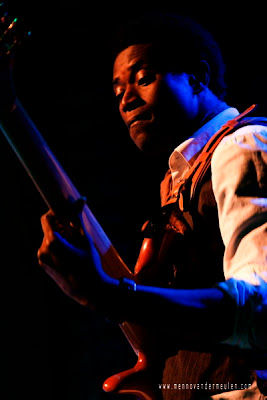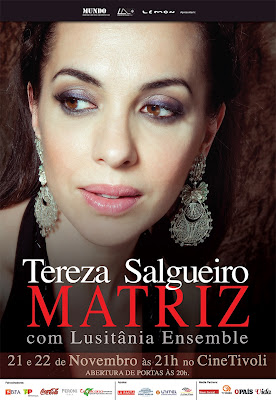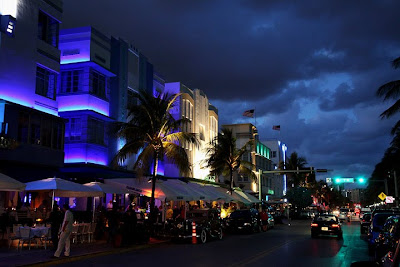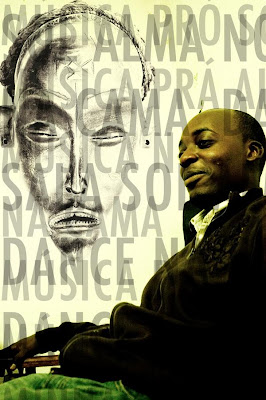
About 25 years ago João Sildes Bunga and his mother left their native lands of Uíge province in northern Angola and, like countless other families, set south for Luanda, to escape the devastating civil war. Their lives in Luanda was one of hardship and hard work, and many times the only diversions for this musical family of two were the guitar sessions they would have with João’s dilapidated instrument. Eventually, João took the name of Wyza as his artistic identity and, through a combination of sheer luck and an immense talent, was able to not only get a song on Luanda’s radio (a track called Mpasi, which in his native Kikongo language means suffering), but to release his first solo album.
Unfortunately his album panned because of a poor marketing campaign, but it got the interest of none other than
Paulo Flores, one of Angola’s best musicians and a man whose musical opinions matter. Wyza was then invited by Paulo Flores to open one his concerts, and from then on news of his music began to spread, quietly and timidly. Wyza’s biggest break however came when he was commissioned to help build
Maianga Producões’ studio in downtown Luanda, the same label responsible for the release of the album
Comfusões. Having seen and heard his musical acumen, Maianga decided to employ Wyza in the studio, and his career began in earnest. Paulo Flores featured him in a track on his album Xe Povo, and a couple of years later Wyza recorded and released his debut album, Africa Yaya.
The two tracks featured below, however, are from Wyza’s second album, Bakongo, my preferred one. Also released by Maianga Produções, it features production work from our well known Mauricio Pacheco (Comfusões,
Stereo Maracanã), from whom I learned about Wyza. Being from Uíge and thus part of the ancient
Kongo Kingdom, Wyza is incredibly proud of his
heritage, and all of his songs to date are sung in the Bakongo language. The Bakongo have their own religion, customs, and music, namely the kilapanga rhythms that Wyza is so fond of. The kilapanga sounds ancient and earthy, and it gives a certain timelessness to some of Wyza’s music, especially the title track Bakongo. But the standout track on the album is Kwassa, a modern yet primeval track highlighting Wyza’s exquisite voice and slick production work from Mauricio (who also plays electric guitar for Wyza), transforming it into a thoroughly enjoyable dance jam. Just wait 'til the beat drops...
BakongoKwassaA cerca de 25 anos atrás o João Sildes Bunga e a sua mãe deixaram as suas casas ancestrais nas terras do Uíge para fugir da guerra e, como muitas outras famílias naqueles tempos, decidiram arranjar uma vida nova em Luanda. As suas vidas em Luanda eram uma luta constante, mas era um pouco atenuada com as sessões de música entre os dois utilizando a viola do João. Eventualmente, o João escolheu Wyza como nome artístico, e, por uma combinação de sorte e trabalho árduo, conseguiu não só por uma música na rádio (Mpasi, que siginifica sofrimento em Kikongo) como também lançou um CD.
Infelizmente, o album não fez lá muito sucesso, sendo uma das razões a sua divulgacão inadequada. Mas conseguiu chamar a atenção do kota
Paulo Flores, apreciador de música boa, e Wyza foi convidado pelo mesmo para abrir um dos seus concertos. Timidamente começou-se a falar deste novo nome do panorama musical angolano, ate ao momento em que Wyza foi contratado para trabalhar na obra de construção dos estúdios da
Maianga Produções, a mesma editora que lançou o album
Comfusões. Impressionado com o seu talento, a Maianga Produções decidiu assinar contrato com o Wyza e por intermédio deles o cantor lançou o seu primeiro album, Africa Yaya, e a sua popularidade despontou.
As duas faixas incluídas aqui são do seu segundo album, Bakongo, que eu prefiro em relação ao primeiro. O album tem dedo do Mauricio Pacheco (Comfusões,
Stereo Maracanã), que não só produziu o CD mas tambem tocou guitarra em algumas músicas. Já que o Wyza é um filho
orgulhoso das terras do Uíge (do antigo
Reino do Kongo), as suas músicas são todas em Kikongo e muitas são do ritmo kilapanga, o ritmo dos Bakongos. O kilapanga é um ritmo bastante rico, e dá uma certa pecularidade as músicas do Wyza. Confire por exemplo a canção Bakongo. Todavia, a melhor música do CD tem que ser Kwassa, que conta com um ritmo moderno e polido e uma energia contagiante. Foi produzida pelo Mauricio e da vontade de dançar. Quem duvida, carregue no play!
-Photo by
ZeibalseroWyza
OnlineWyza on
Myspace






































